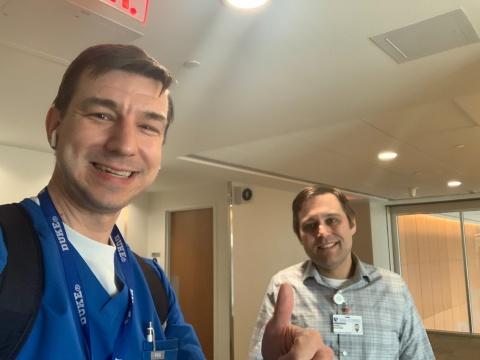
Photo: Dr. Jason Theiling with Dr. Daniel L. Gilstrap
This story is part of an ongoing series of reflections from Duke Surgery faculty and staff.
Since the COVID-19 pandemic began, Dr. Jason Theiling spends most of his time in the emergency department. As medical director, he now works most days of the week to treat patients requiring emergency care while meeting the new demands of the pandemic.
“A lot of what I've done, from the medical director standpoint, has essentially shifted from all the other work that I do on a daily basis, almost 100% to COVID every day,” says Dr. Theiling. “Days have certainly gotten longer. I'm here six or seven days out of the week either administratively on a clinical shift as opposed to five or six.”
Dr. Theiling says they are seeing a decrease in the number of patients visiting the emergency department, potentially due to fears of infection from the SARS-CoV-2 virus. According to Dr. Theiling, stroke volume has decreased by 20%, and similar decreases have been observed for heart attacks and trauma. He is concerned that patients may be ignoring “true emergencies” and encourages patients to seek urgent care when needed.
While visits are down, the severity of cases has increased. In the intensive care unit (ICU), more patients require drastic interventions, such as intubation and ventilators.
“We would see two or three people a day that we would send to an ICU on a ventilator. Now, there are numerous days where we have three people getting intubated at the same time, and double or even triple those numbers go into an ICU on a ventilator. The actual acuity of the work is going up even though the volume is going down so the shifts are no less busy.”
Dr. Theiling says team members in the emergency department remain committed as ever to providing high-quality care to patients. Duke Health now offers virtual visits, telehealth, and a tent for drive-through testing for COVID-19. Rapid testing is enabling patients to receive treatment faster when they do come to the ED. Thanks to the introduction of a rapid point-of-care COVID-19 diagnostic test, the team can test for the virus at the patient’s bedside.
“Duke was one of the first groups in this area that had the ability to test and then we were the first to be able to do it at the hospital, which meant, instead of taking a day or two, it would take hours. Then, we rolled out our point-of-care testing, which is really minutes. We’re able to easily test all those patients in the emergency department inside of 15 minutes."
While the team is working to treat patients with COVID-19 and to test as many patients as possible to determine the true incidence of infection, Dr. Theiling is worried about the potential resurgence of COVID-19 in the fall.
“It's possible it could come back and we could be in the exact same situation in the fall that we are in right now,” explains Dr. Theiling. “We'll have six months to game plan and try to make improvements, but my biggest concern is that because it is so infectious once it gets into a community it can spread really quickly without aggressive measures like stay-at-home orders.”
During this difficult time, he says a tremendous sense of camaraderie among team members provides much-needed support. This cooperation is inherent in their team’s care model in the emergency department.
“One of the great things about working in the ED is that we have a true kind of sense of teamwork,” he says. “You can't go through a single shift without relying on each other. Very rarely do you have care that's carried out without input from everybody on the team. Because of that, we already kind of have a teamwork mentality.”
From watching each other closely when taking personal protective equipment on and off to bringing in food, “thank you” cards, and hand-drawn pictures from each other’s children, team members show support and gratitude when they can.
“You very much get the feeling that everybody's in the same boat,” says Dr. Theiling. “You're all rowing in the same direction and you have to look out for each other.”

The Emergency Medicine team practices social distancing during the Thank You Duke Health parade.
Give to Duke Emergency Medicine
The Duke Division of Emergency Medicine relies on individual gifts and philanthropic partnerships to help support our clinical, research, and educational missions and to secure funds for the future.
